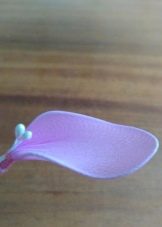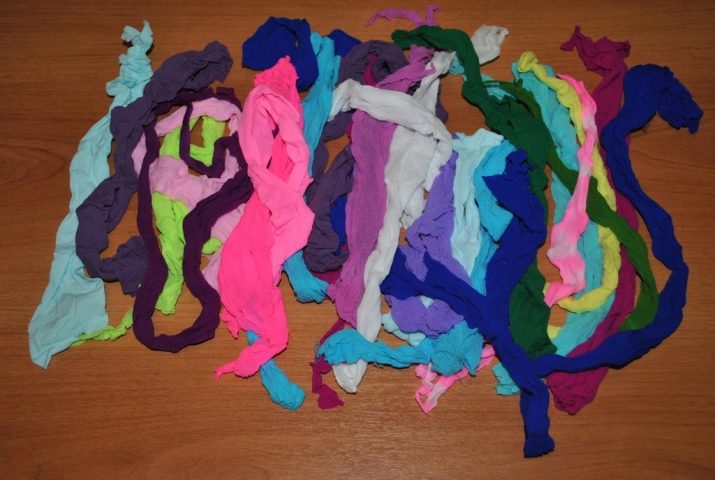Nylon flowers and wire can be a great holiday gift. They will decorate the interior, make it more comfortable. From the material in this article you will learn how and what they are made of, what techniques they use.



Tools and materials
The main raw material of floral decoration is nylon fabric. It is made on special equipment specifically for creativity. This raw material is durable and durable, it is thin and transparent. Its texture is varied: plain, multi-colored, openwork, shiny.
Floristic nylon stretches perfectly, while not being deformed when pulled onto the frame. It is sold in cuts, the length of which is about 50–85 cm. Such a quantity is quite enough, since in the stretched form the cut length increases to one and a half meters. In the absence of such a nylon, nylon socks, socks, tights are used, giving them the right shade with acrylic paint.

Wireused in the work is notable for its flexibility, color variety, thickness, rigidity, texture.
The type of wire depends on what it is used for.
For example, for the petals they take the thinnest wire, which is easier to bend, giving the necessary shape. For stems use more dense and stiff material.

The wire for making flowers is distinguished by the texture of the surface. It is typical, lint-free, with a paper braid, as well as fluffy. The length of the wire segments varies from 30 to 80 cm. The standard values are 30, 40, 50, 60, 70 and 80 cm. In addition, wires 45 and 75 cm long are also on sale.Material for the construction of petals is sold not only in the form of cuts of 80 cm, but also in meter.
When buying a particular type of floristic material, they look at its marking: the larger the number, the thinner the wire. Thickness can vary from 18 to 30.


The work can not do without templates. They are also sold in specialized stores for needlework and are sets of 8 cylinders of different diameters. Templates have their own marking and are designed for the specific thickness of the wire used. For example, the template number:
- 1 has a diameter of 1.7 cm;
- 2 slightly larger - 2.1 cm;
- 3 is 2.5 cm in diameter;
- 4 is 3.2 cm in diameter;
- 5 has a diameter of 4 cm;
- 6 is 5 cm in diameter;
- 7 is used for large parts (6.4 cm);
- 8 - the largest, is 7.5 cm in diameter.
In this case, the first 3 templates are designed to work with a wire thickness of 26 to 30. The largest template is needed for thick wire marked 18–20.
Templates are indispensable tools in the work, they allow you to calculate the approximate number of petals to buy the exact amount of nylon.


In addition to kapron and wire, other devices and tools are also used in the manufacture of flowers. The main ones are:
- scissors (ordinary small or manicure type);
- wire cutters or pliers (for cutting and bending the wire);
- threads from nylon (for fixing kapron material on the frame and connecting parts);
- improvised materials for wire (batteries, tubes, bottles);
- teip tape for needlework (to mask joints and fasten parts).

In addition, stamens, beads, food colors, pencils, sepals, leaves, floral decor from synthetic materials for needlework and even ordinary cotton wool may be needed in the work. As for the instruments, without them it simply will not be possible to assemble all the elements of the composition together. In addition to scissors and pliers, round-nose pliers and a glue gun will come in handy.



Execution technique
Making flowers from kapron and wire with your own hands is not difficult, taking as a basis the lesson of the master. Any needlework master class consists of a series of consecutive steps. First you need to make the basic elements of the composition, and then gradually assemble them. Masters make compositions according to proven schemes.
It is easier for beginners to rely on video or text lessons with photos of each stage of work.
The principle of operation is not too different from the assembly of flowers from textiles. The key difference will be the manufacture of a wire frame and pulling a capron on it. In this case, a thread will be used to fix the petals, the stems will have to be masked with tape. Let's take a step-by-step master class for beginners, describing the essence of the work.

For the manufacture of petals, templates of the required size are prepared, a thin wire and a nylon of a favorite shade. The wire is wrapped around the template, twist its ends with pliers. The wire ring is removed from the base. After that, the petals are given the necessary shape: stretched, bent, create the effect of an uneven edge.

Then, a capron is pulled on the obtained blanks, fixed at the base and the excess material is cut off. Petals try to make with a minimum number of folds. By this principle, 5 petals are made. After that, they are twisted together, inserting pre-prepared stamens into the middle.
The ends of the excess wire are cut with wire cutters. According to this scheme, 2 more flowers are made. The principle of creating leaves can be exactly the same. However, their shape is more elongated and pointed, for them take larger templates.
So that the threads in the work do not contrast with the color of the material, try to use those that are most suited to the shade of the petals and greenery.

When the elements are ready, proceed to the assembly of the flower. The stem is formed, adding to it, in addition to flowers, oblong leaves.Wrap it with teyp tape at an angle, trying to do it as accurately and tightly as possible. As the winding is completed, the tape is cut.

According to this scheme, you can make bouquets of different colors, decorating them with windows, curtains and even wallpaper. Delicate orchids, bells, chamomiles, snowdrops. In addition, using this technique, you can make not only artificial flowers for decoration, but also hair ornaments, as well as brooches. For example, it can be headbands with roses, lilies, poppies, tiaras and even elastic bands.

The subtleties of creating orchids
When creating orchids, there are some nuances. The flower consists of 6 wire loops with legs 2.5 cm long; on one petal, the length of the leg is equal to the length of the stem. The petal frames are made of wire No. 22 and a 3.5 cm template. The loops are pulled into a drop shape, one is made oval. After this, the frames are fitted with white nylon and fixed with threads.



Over the white skin, the petals are wrapped in a second layer, using a two-tone white-pink nylon, fixing it with threads. Excess threads are cut. Stamens are wound onto an oval-shaped petal, then bent. Next, 2 petals are added to the base, creating a triangular shape. Under them add another 3 petals, placing them in a checkerboard pattern.
When the flower base is ready, the petals are shaped. Take a teip tape and wrap the stalk. After that make the buds. Take 2 pieces of wire No. 07, cut in half, twist in the middle. From the middle of 8 wires make the shape of a bud. By this principle, several blanks are created.




Half of them are covered with white-purple capron, half - green. After that, the stalks are wrapped with teip tape. Leaves are made using large patterns, after which roots are made by wrapping the wire with a white and green teip tape.
After that, the wrapped wire is bent into a spiral shape and connected at the base. Then they begin to assemble the flower, starting with green buds. Leaves are connected by 2, winding to the stem with a teip tape. When the flower is ready, it is "planted" in a prepared pot with moss.


Recommendations
When making flowers from nylon and wire, you can take into account several tips from experienced craftsmen. For example, they advise taking material for different windings, including related shades. This allows you to create flowers with the most naturalistic look. In this case, the stamens and middles are also recommended to be taken as realistic as possible.
Beginners can use ready-made leaves for flowers and plastic sepals in their work. They will hide the flaws of the work and give the composition a natural look.
If it is difficult for beginners to collect elements with threads, you can use a hot glue thermal gun. It’s better to buy a model for narrow rods - it’s more convenient to work with it, and the glue consumption for such products is more economical.

The appearance and color of the wire are of considerable importance. Sometimes it’s they who give a special effect to the product. If you need a corrugated edge, it is better to buy thinner material.
For realism, it is worth choosing a wire to match the nylon used or a little lighter / darker.
As for the thickness of the wire, it has a significant impact on the quality and aesthetics of the work. Do not take too thick and stiff wire if a small flower is made. It is necessary to bend it very carefully, because the tape tape will not hide all the defects of the winding. In this case, the stem or petals will look rough, unrealistic.

You should not save on kapron, despite the fact that it can be painted. Craftswomen are advised to immediately buy several shades of material. At the same time, white, green and brown colors must be included in the basic kit. The remaining shades depend on the type of flowers you want to make. Usually it is pink, purple, lilac tones.

The complex shape of the petals is done according to different schemes. For example, when a corrugated edge is needed, the wire is first bent and only after that is a wire frame made of it.Often, petals are created from 4 wire strands. For this, 2 thin wires are cut in half and twisted in the middle.
Then double petals of various shapes are formed from them. The wavy edge of large petals can be done after creating a skeleton base.

When making flowers, one must not forget about the whole composition. Single items can be attached to tulle, mini-flowers - for hairpins, brooches, elastic bands for hair. Bouquets need beautiful flowerpots or pots. Their filling can be different (from foam rubber to soil, moss, sisal). The base of the pots must be stable.

Even experienced craftsmen work with a vivid example, using a photograph of real flowers as an idea. So the shape of the petals, leaves, the number of buds, bends, proportions, shades, stamens are better visible. Before starting, you need to carry out an approximate calculation of the necessary material. In the process you need to use quality toolsshould work putting a protective coating on the work surface.

The following video presents a master class on creating a flower from kapron.










